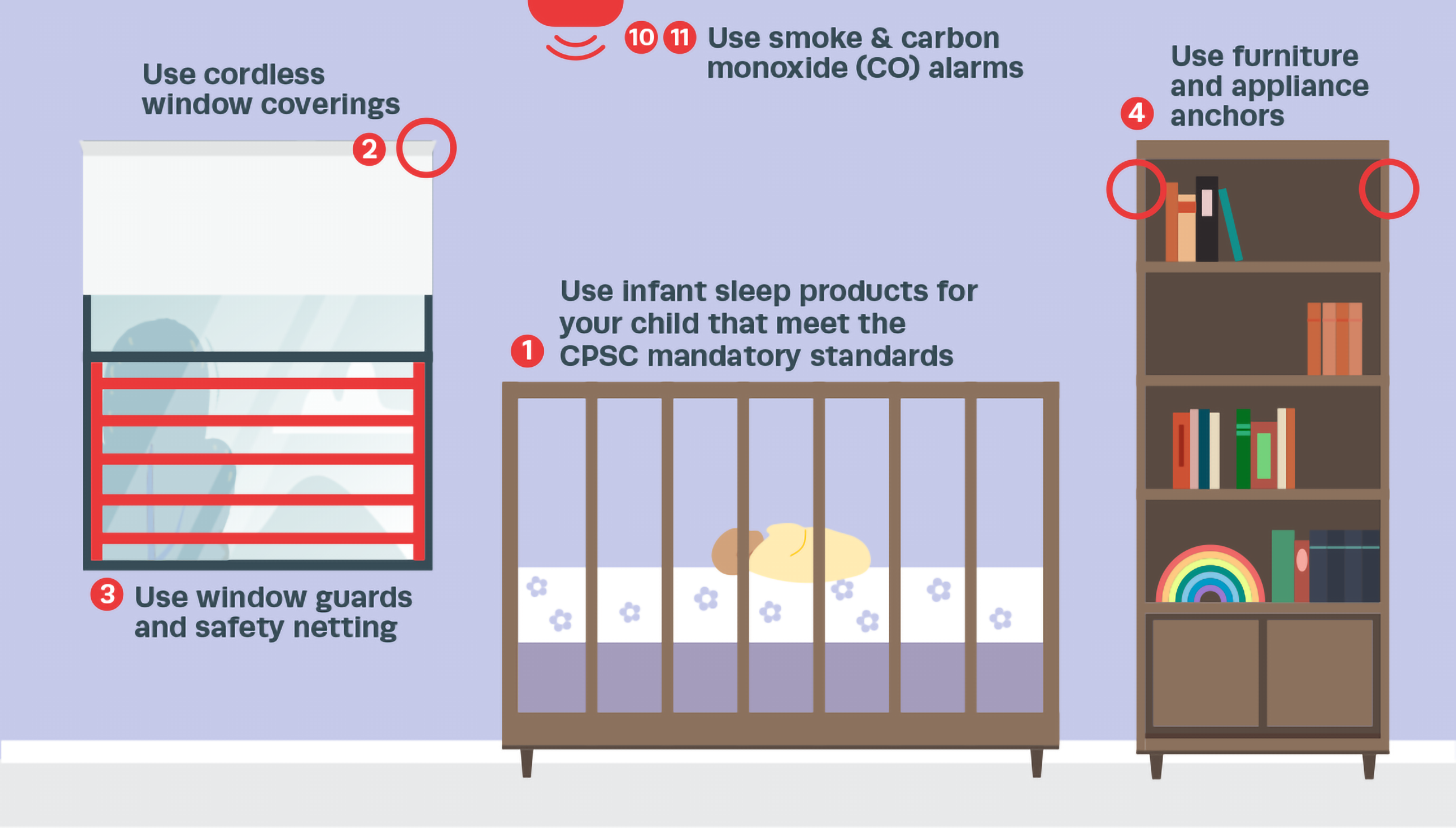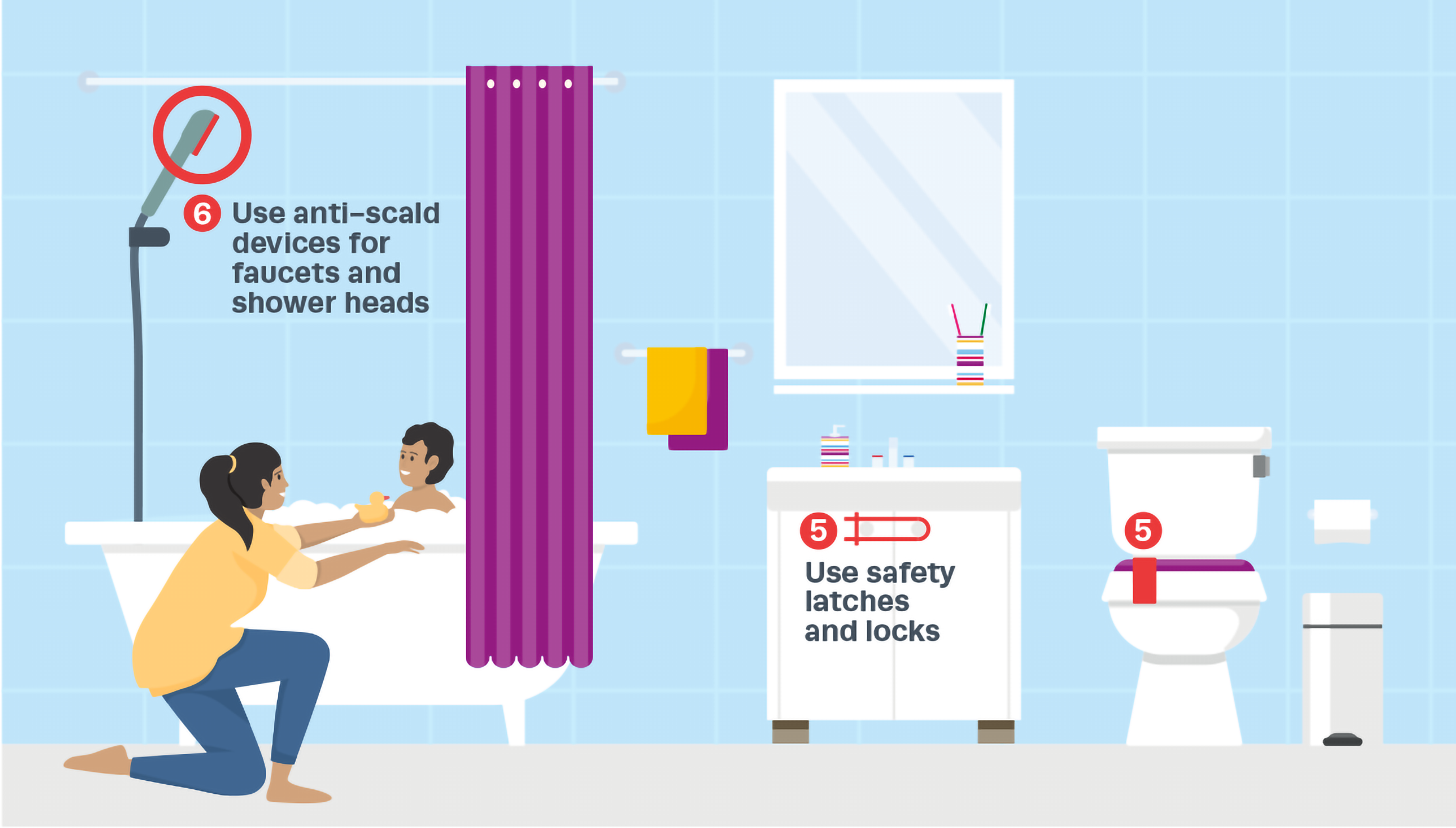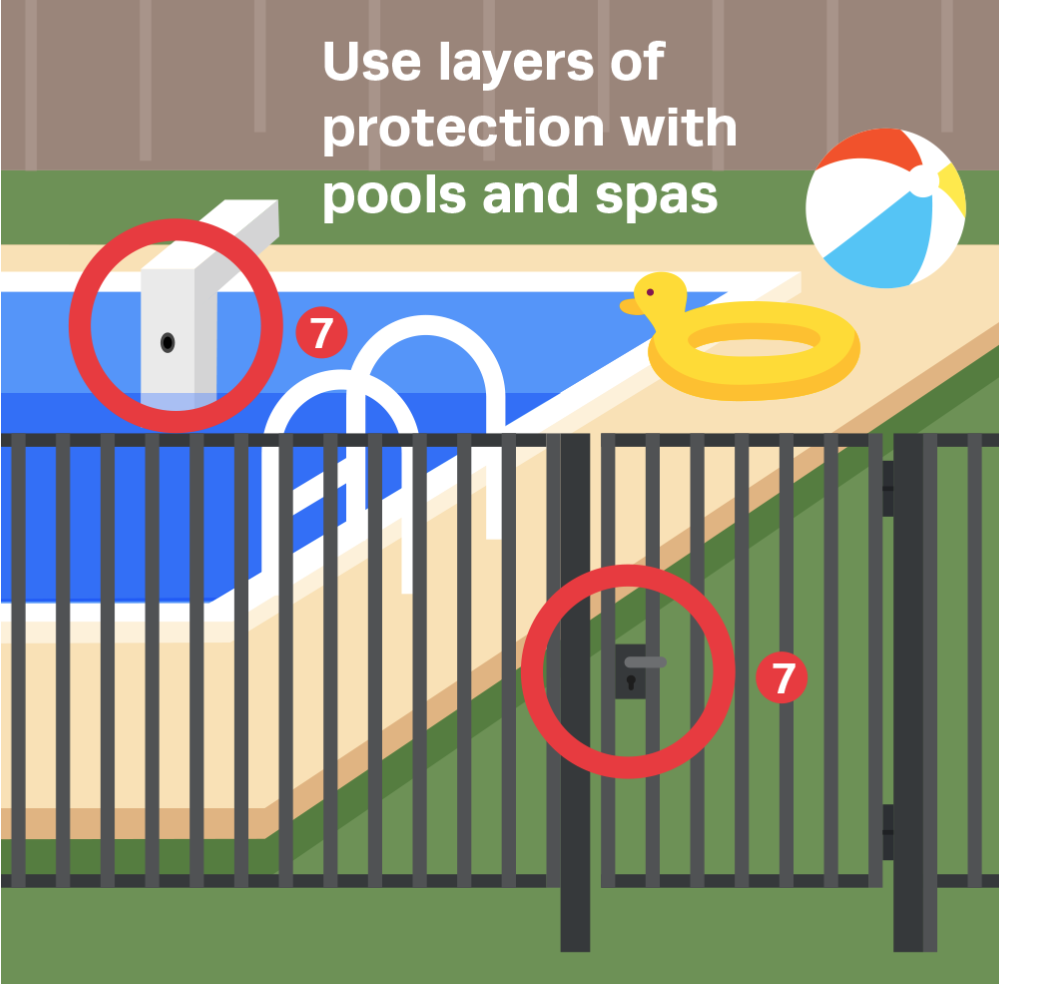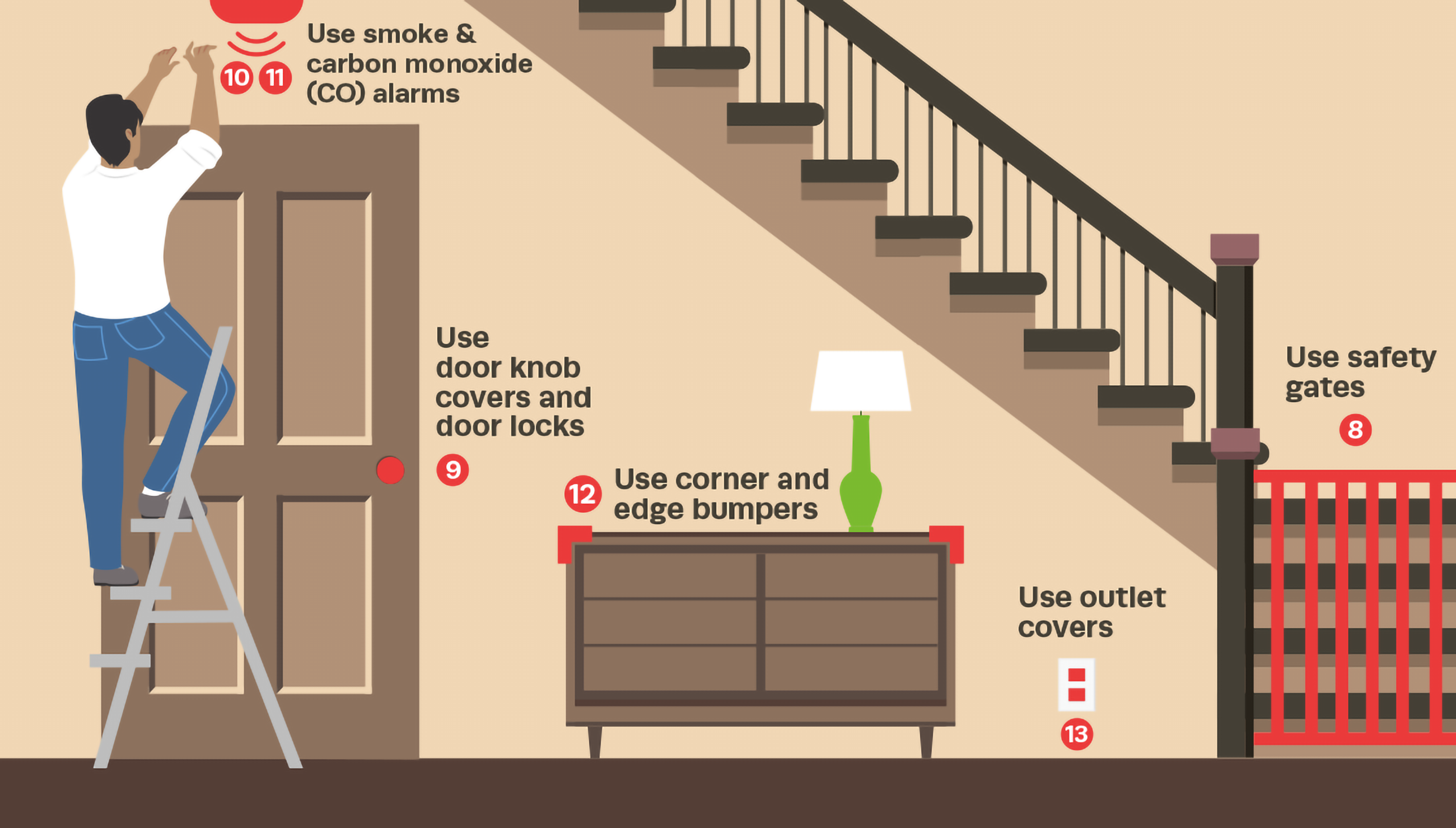Each year, children are injured by hazards in and around the home. The good news is that the risk of injury can be reduced or prevented by using recommended safety practices, by using child products that meet safety standards, and by using child-safety devices. Most of the safety devices are easy to find and are relatively inexpensive. To be effective, they must be properly installed and reengaged after use. Follow installation instructions carefully. Remember, too, that no device is completely childproof; determined toddlers have been known to overcome or disable them.
Here are some safety practices, recommended product that meet safety standards, and child safety devices that can help reduce injuries to young children. The numbers correspond to those in the images.

Use Infant Sleep Products that Meet the CPSC Mandatory Standards (1) for your child.
These products include bassinets and cradles, baby cribs, play yards, or bedside sleepers. Place your baby inside on the firm flat sleep surface, on their back, and alone with no added items in the sleeping area.
Use Cordless Window Coverings (2) in homes with young children, to help prevent strangulation. Children can wrap window covering cords around their neck, or they can pull cords that are not clearly visible, but are accessible, and become entangled in the loops. Cordless products, including inexpensive options, are available at most major retailers and online. If you are unable to replace corded window coverings with cordless ones, call the Window Covering Safety Council at 800-506-4636 or visit WindowCoverings.org for a free repair kit. Use tension devices to anchor the continuous loops and bead chains to the floor or wall. The WCSC’s retrofit kits do not address the dangling pull cord hazard associated with many common window blinds. Eliminate any dangling cords by making the pull cords as short as possible.
Use Window Guards and Safety Netting (3) to help prevent falls from windows, balconies, decks, and landings, because window screens are not effective for preventing children from falling out of windows. Check these safety devices frequently to make sure they are secure, properly installed and maintained. Limit window openings to four inches or less, including the space between the window guard bars. If you have window guards, be sure at least one window in each room can be easily used for escape in a fire.
Use Anchors to Avoid Furniture and Appliance Tip-Overs (4) Furniture, TVs and ranges can tip over and crush young children. Deaths and injuries occur when children climb onto, fall against or pull themselves up on television stands, shelves, bookcases, dressers, desks, chests and ranges. For added security, anchor these products to the floor, or attach them to a wall. Free standing ranges and stoves should be installed with anti-tip brackets to prevent scalding and crushing injuries.

Use Safety Latches and Locks (5) for cabinets and drawers in kitchens, bathrooms and other areas to help prevent poisonings and other injuries. Safety latches and locks on cabinets and drawers can help prevent children from gaining access to medicines, laundry detergent, household cleaners, matches, or cigarette lighters, as well as knives and other sharp objects. Even products with child-resistant packaging should be locked away and kept out of reach. Often, this type packaging is not childproof. If you suspect that your child ingested a poisonous substance, contact the poison control hotline (800) 222-1222. Look for safety latches and locks that adults can easily install and use, but are sturdy enough to withstand pulls and tugs from children.
Give constant supervision and stay within reach when your baby is bathing. Children can drown in moments. To prevent burns, the temperature on your water heater can be set to 120 degrees Fahrenheit or lower. Anti-Scald Devices (6) for faucets and shower heads can also be used to prevent scalding or burns.

Use Layers of Protection with Pools and Spas (7). Most toddler drownings occur in their own backyard pools. Always check the pool first if your child goes missing. The access from the back of your house may need to serve as a barrier to delay your child’s access to the pool. Doors heading to the pool should have self-closing, self -locking door mechanisms or door alarms. Other pool barriers include power safety cover, pool alarms, self-closing and self-latching pool gates, isolation and perimeter fences, and pool covers. After each pool use, reestablish the barrier to ensure that your child is accessing the pool and spa only when you are supervising.

Use Safety Gates (8) to help prevent falls down stairs and to keep children from entering rooms and other areas with possible dangers. Use safety gates that meet current child safety standards. Pet gates should never be used as a child safety gate. Replace older safety gates that have “V” shapes that are large enough to entrap a child’s head and neck. Look for safety gates that children cannot dislodge easily, but that adults can open and close without difficulty. For the top of stairs, only use gates that screw to the wall.
Use Door Knob Covers and Door Locks (9) to help prevent children from entering rooms and other areas with possible dangers. Door knob covers and door locks can help keep children away from places with hazards. Be sure the door knob cover is sturdy and allows a door to be opened quickly by an adult in case of emergency.
Use Smoke Alarms (10) on every level of your home, inside each bedroom, and outside sleeping areas to alert you to fires. Smoke alarms are essential safety devices for protection against fire deaths and injuries. Check smoke alarms once a month to make sure they’re working. Change batteries at least once a year, or consider using sealed, 10-year batteries for smoke alarms, because these do not require changing batteries yearly.
Use a Carbon Monoxide (CO) Alarm (11) to help prevent CO poisoning even when the home does not have fuel-burning appliances. All consumers should install CO alarms outside of bedrooms near each sleeping area of the home, even if the home does not have any fuel-burning appliances. Test regularly, and change batteries at least once a year.
Use Corner and Edge Bumpers (12) to help prevent injuries from falls against sharp edges of furniture and fireplaces. Be sure to look for bumpers that stay securely on furniture or hearth edges.
Use Outlet Covers and Outlet Plates (13) to help prevent electrical shock. Outlet covers and outlet plates can help protect children from electrical shock and possible electrocution. Be sure outlet protectors cannot be easily removed by children and are large enough so that children cannot choke on them. If you are replacing receptacles, use a tamper-resistant type.





